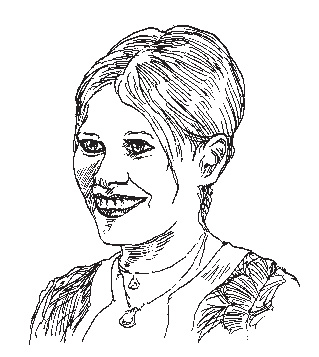Heba Thorisdottir, the forty-something makeup artist, has one of those enviable peaches-and-cream complexions generally associated with prepubescent girls, or the backsides of babies and women who get crooned about in R&B songs. It’s no surprise, really, as Heba’s trade is skin. You’ve most likely seen her work, artfully inconspicuous, though omnipresent in the faces of Kill Bill: Vol. 1’s anime-eyed teenage villain, Gogo Yubari, the relaxed natural beauty of Cate Blanchett in The Life Aquatic, the spy superhero femme fatale Scarlett Johansson in The Avengers, and various characters in Bridesmaids, Hanna, Inglourious Basterds (Heba is Tarantino’s go-to brush master), The Curious Case of Benjamin Button, and We Bought a Zoo. Her red-carpet and print portfolios are also nearly endless. She works most regularly with Blanchett and Johansson as their personal makeup artist.
Heba and I spoke for more than two hours at her home in Los Angeles. Before I left, she offered me a bag of fresh lemons from her tree and a free makeup consultation, during which she swished and poked a few of my own makeup products onto my face with smooth, expert fingers. Two and a half minutes later, she pointed toward the mirror behind my head. When I turned to inspect my face, it seemed as though it was bare, yet I’d never looked better.
—Kathryn Borel
THE BELIEVER: Did you have a natural predilection for color or the human face?
HEBA THORISDOTTIR: I remember going through my mom’s makeup bag and trying all sorts of stuff, putting on tanner, playing with color. For me, it wasn’t just about trying to make myself pretty or have longer lashes. I was experimenting with it in ways that went beyond beauty.
BLVR: What did you like about it?
HT: It seemed artistic and interesting. What I think I picked up—but didn’t realize until later—was the psychological aspect of the job. I think I’m a better psychologist than I am a makeup artist. Because when you have actors in your chair, you have to be aware that makeup, hair, and wardrobe are the last steps before they go on camera. And because we’re the last people they see, we can change an actor’s attitude. Sometimes I’ll get a really nervous person in the chair, especially when we’re working with Quentin Tarantino. Actors especially adore him, and they don’t want to do anything wrong. They are so stressed by the idea of letting Quentin Tarantino down, and so they’re wrecks by the time they get to me. It’s my job to make them comfortable… And I’m sometimes not necessarily doing something...
You have reached your article limit
Sign up for a digital subscription and continue reading all new issues, plus our entire archives, for just $1.50/month.
Already a subscriber? Sign in





